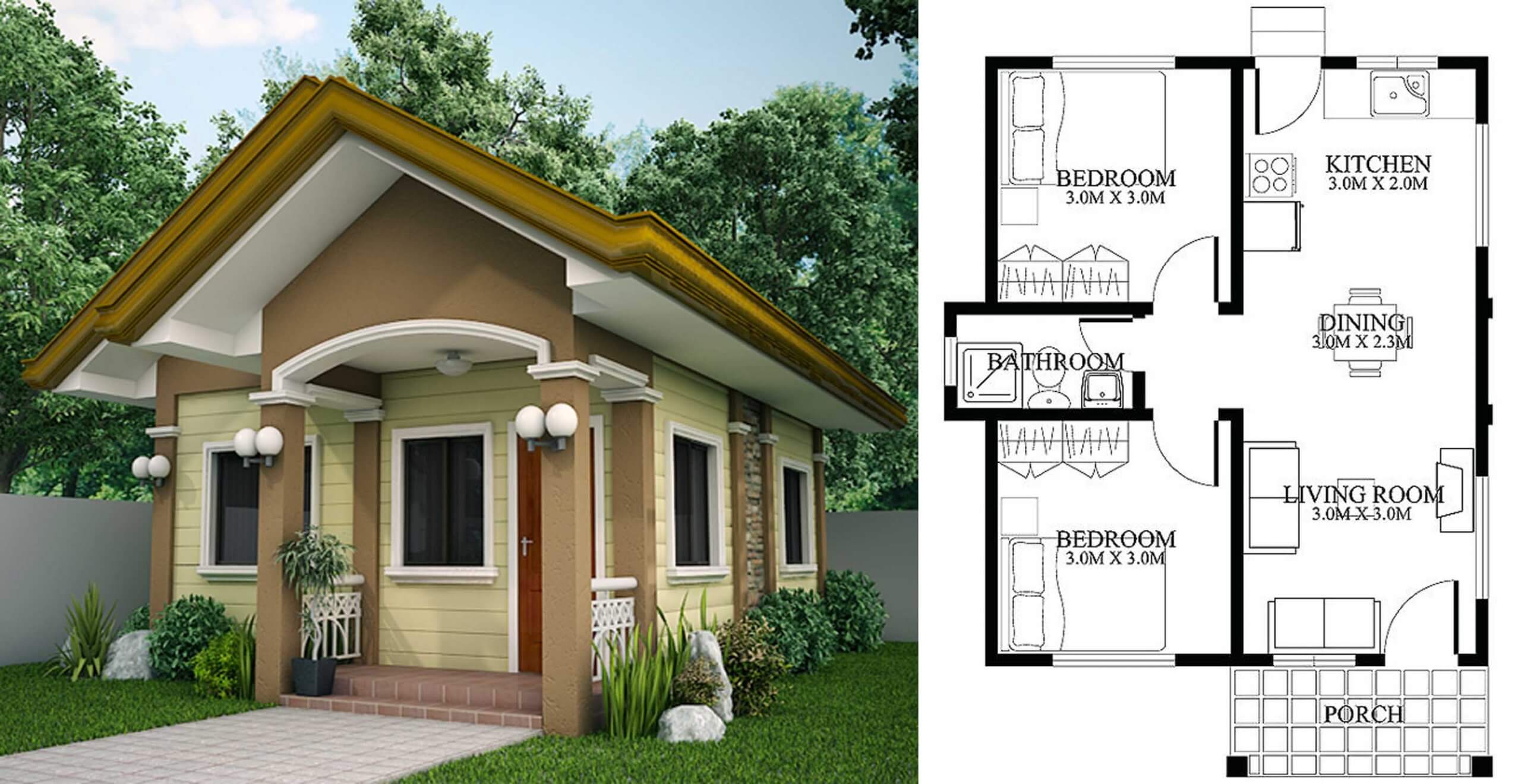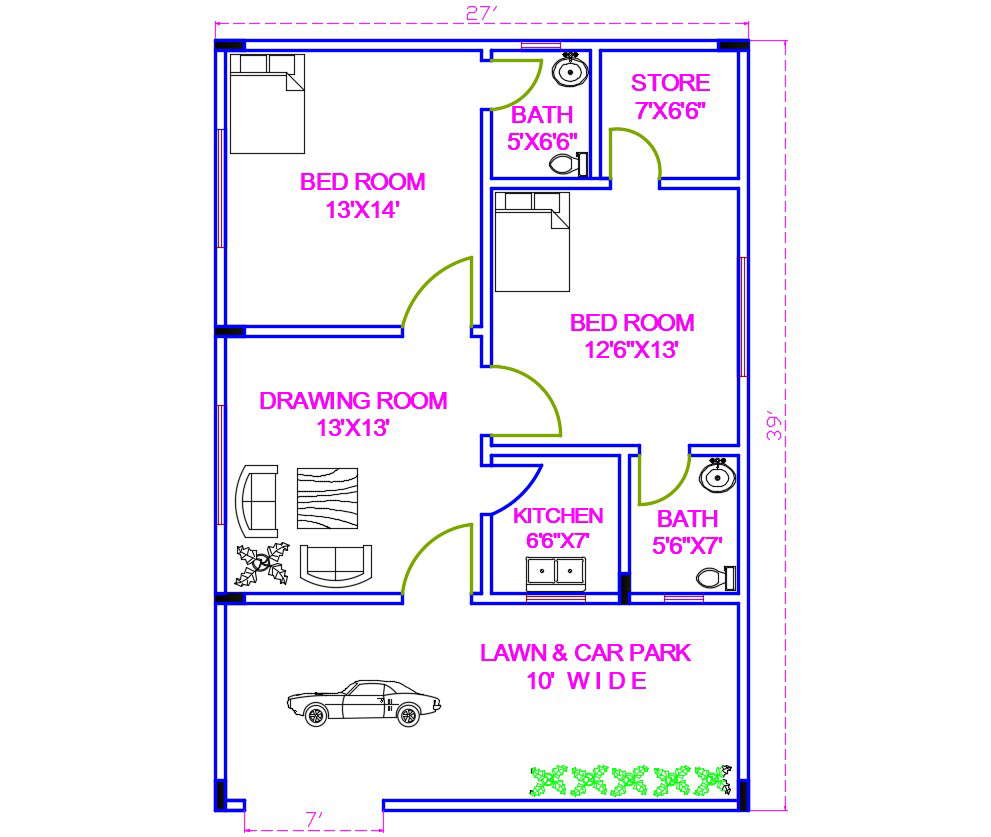Understanding the Appeal of 2-Bedroom Indian House Plans: 2 Bedroom Indian House Plans

The popularity of 2-bedroom homes in India stems from a confluence of cultural preferences, evolving family structures, and economic considerations. These homes offer a balance between space and affordability, catering to the needs of a diverse population.
Cultural Influences on Design
Indian culture heavily influences the design and layout of homes. The concept of “Vastu Shastra,” an ancient Indian architectural science, plays a significant role in shaping the layout of houses, emphasizing harmony between the natural world and human habitation.
- Courtyards: Courtyards are often incorporated into 2-bedroom homes, providing a central space for family gatherings and natural light. They symbolize openness and connection to the outdoors, a key element in Indian culture.
- Family-Oriented Design: 2-bedroom homes are often designed with the needs of families in mind, prioritizing shared spaces for communal living. The living room, for example, is often central and spacious, accommodating family gatherings and celebrations.
- Spiritual Spaces: Many Indian homes include dedicated spaces for prayer and meditation, reflecting the importance of spirituality in Indian culture. These spaces, often called “pooja rooms,” are typically small but carefully designed, showcasing intricate details and religious iconography.
Types of 2-Bedroom Homes in India
The Indian housing market offers a diverse range of 2-bedroom homes, each catering to different needs and preferences.
- Independent Houses: These homes provide complete privacy and ownership, offering ample space for family life. They are often favored by families with young children or those who value a sense of community within their neighborhood.
- Apartments: Apartments are a popular choice for young professionals and families seeking a more compact and affordable option. They often come with amenities like swimming pools, gyms, and playgrounds, enhancing the quality of life for residents.
- Duplexes: Duplexes provide a blend of privacy and community living. They offer two separate units within the same building, with shared entrances and sometimes common areas. They are a good option for families seeking a balance between space and affordability.
Key Design Considerations for 2-Bedroom Indian House Plans

Designing a 2-bedroom Indian house plan involves harmonizing traditional architectural elements with modern amenities and functionality. This delicate balance ensures a comfortable and practical living space that reflects the rich cultural heritage of India.
Traditional Architectural Elements
Traditional Indian architecture emphasizes open spaces, courtyards, and intricate details. Incorporating these elements into a modern 2-bedroom house plan adds character and cultural significance.
- Courtyards: Central courtyards bring in natural light and ventilation, creating a sense of openness and connection with nature. They also serve as a gathering space for family and friends.
- Jali Work: Intricate latticework screens called “jali” are a hallmark of traditional Indian architecture. They provide privacy while allowing light and air to circulate through the house.
- Verandas: Covered verandas offer a shaded space for relaxation and socializing. They are often adorned with decorative pillars and intricate carvings.
- Vaastu Principles: Vaastu Shastra, an ancient Indian system of architecture, emphasizes the alignment of a building with the cardinal directions. Incorporating Vaastu principles can create a harmonious and balanced living environment.
Modern Amenities and Functionality
Modern amenities enhance the comfort and convenience of living in a 2-bedroom Indian home. These amenities should be integrated seamlessly into the design, ensuring both functionality and aesthetics.
- Open Plan Living: Open plan living areas create a spacious and inviting atmosphere, blurring the lines between the kitchen, dining, and living spaces.
- Modern Kitchen: A well-equipped kitchen with ample storage and modern appliances is essential for contemporary living. Consider incorporating a breakfast bar or island for casual dining.
- Smart Home Features: Smart home technology, such as automated lighting, security systems, and climate control, adds convenience and efficiency to daily life.
- Sustainable Features: Sustainable design elements, such as solar panels, rainwater harvesting systems, and energy-efficient appliances, reduce the environmental impact of the home.
Common Design Layouts and Space Allocation Strategies
The layout of a 2-bedroom Indian house plan is crucial for maximizing space and creating functional living areas. Common layouts and space allocation strategies include:
- Linear Layout: This layout features a long, narrow footprint with rooms arranged in a straight line. It is suitable for narrow plots of land and provides a clear flow of movement.
- L-Shaped Layout: An L-shaped layout creates distinct zones within the house, with the living area often located at the corner of the L. This layout provides privacy and flexibility in space allocation.
- U-Shaped Layout: A U-shaped layout creates a central courtyard or open space, with rooms arranged around the perimeter. This layout is ideal for maximizing natural light and ventilation.
Living Areas
The living area is the heart of the home, a space for relaxation, socializing, and entertainment. It should be designed to be comfortable and inviting, with adequate seating, storage, and natural light.
- Open Plan Living: An open plan living area combines the living, dining, and kitchen spaces, creating a spacious and airy atmosphere.
- Separate Living Room: A separate living room provides a dedicated space for relaxation and entertainment, offering privacy from other areas of the house.
- Family Room: A family room can be a more casual space for watching TV, playing games, or simply spending time together.
Bedrooms
Bedrooms should be peaceful and relaxing retreats, providing a comfortable space for sleep and rest. Consider the following factors when designing bedrooms:
- Size and Layout: Bedrooms should be large enough to accommodate a bed, wardrobe, and other furniture comfortably.
- Natural Light and Ventilation: Adequate natural light and ventilation are essential for creating a pleasant and healthy sleeping environment.
- Storage: Built-in wardrobes or ample closet space are essential for keeping bedrooms organized.
- En Suite Bathrooms: An en suite bathroom provides privacy and convenience, especially in master bedrooms.
Kitchens
The kitchen is the heart of the home, where meals are prepared and families gather. A well-designed kitchen should be functional, efficient, and aesthetically pleasing.
- Work Triangle: The work triangle, connecting the sink, stove, and refrigerator, should be designed for efficient movement and workflow.
- Storage: Ample storage space is essential for keeping the kitchen organized and clutter-free.
- Countertop Space: Sufficient countertop space is needed for food preparation and serving.
- Ventilation: Good ventilation is essential for removing cooking odors and steam.
Bathrooms
Bathrooms should be clean, comfortable, and functional spaces for personal hygiene and relaxation.
- Layout and Fixtures: Consider the size and layout of the bathroom to ensure adequate space for fixtures, such as a toilet, shower, and sink.
- Ventilation: Good ventilation is essential for preventing moisture buildup and maintaining a fresh and hygienic environment.
- Storage: Built-in shelves, cabinets, or drawers provide convenient storage for toiletries and towels.
- Lighting: Adequate lighting is crucial for performing tasks and creating a pleasant ambiance.
Incorporating Natural Light and Ventilation, 2 bedroom indian house plans
Natural light and ventilation are essential for creating a healthy and comfortable living environment in a 2-bedroom Indian home.
- Large Windows: Large windows allow ample natural light to flood the interior, creating a bright and airy atmosphere.
- Skylights: Skylights bring natural light into areas that may not have access to windows.
- Courtyards: Central courtyards provide natural light and ventilation to the surrounding rooms.
- Jali Work: Intricate latticework screens called “jali” allow air to circulate through the house while providing privacy.
- Cross Ventilation: Placing windows on opposite sides of the house allows for cross ventilation, creating a constant flow of fresh air.
Essential Elements for 2-Bedroom Indian House Plans

The essence of a home lies not just in its structure but in the harmonious blend of elements that create a space where life unfolds with comfort, purpose, and joy. For a 2-bedroom Indian house plan, this harmony is achieved through a thoughtful selection of building materials, furniture, decor, and sustainable practices that resonate with the cultural heritage and contemporary aspirations of the inhabitants.
Building Materials
Understanding the unique characteristics of building materials is crucial for ensuring the longevity, durability, and aesthetic appeal of a 2-bedroom Indian home. The following table presents a comparison of commonly used materials, highlighting their advantages and limitations:
| Material | Pros | Cons |
|---|---|---|
| Brick | Durable, fire-resistant, affordable | Requires skilled labor, can be heavy, may require maintenance |
| Concrete | Strong, versatile, cost-effective | Can be prone to cracking, requires careful curing, may not be aesthetically pleasing |
| Stone | Elegant, durable, weather-resistant | Expensive, requires specialized labor, can be heavy |
| Wood | Warm, aesthetically pleasing, renewable | Susceptible to termites and fire, requires regular maintenance |
| Steel | Strong, durable, fire-resistant | Can be expensive, may require specialized labor, can be susceptible to corrosion |
Furniture and Decor
The furniture and decor chosen for a 2-bedroom Indian home often reflect the family’s cultural heritage, personal style, and lifestyle.
- Traditional Indian Furniture: A 2-bedroom Indian home may feature traditional furniture pieces like carved wooden beds, intricately designed chests, and handwoven rugs. These elements bring a touch of history and artistry to the space.
- Modern Indian Decor: Contemporary design trends are also embraced, incorporating modern furniture with vibrant colors, geometric patterns, and metallic accents. This blend of traditional and modern creates a unique and inviting ambiance.
- Religious Icons: Many Indian homes include religious icons or shrines, reflecting the spiritual beliefs of the family. These may be placed in dedicated spaces or incorporated into the overall decor.
- Textiles: Indian homes often feature a variety of textiles, including colorful saris, handloom fabrics, and intricate embroidery. These textiles add a touch of warmth and vibrancy to the space.
Sustainable Features and Energy-Efficient Solutions
The design of a 2-bedroom Indian home can incorporate sustainable features and energy-efficient solutions to minimize environmental impact and promote long-term savings.
- Solar Water Heating: Installing solar panels for water heating can significantly reduce reliance on conventional energy sources, lowering utility bills and reducing carbon footprint.
- Energy-Efficient Appliances: Choosing appliances with energy-efficient ratings can contribute to lower energy consumption and reduce electricity bills. This includes refrigerators, air conditioners, and lighting fixtures.
- Rainwater Harvesting: Implementing rainwater harvesting systems can collect and store rainwater for various uses, reducing reliance on municipal water supply.
- Green Roof: A green roof, covered with vegetation, helps regulate indoor temperatures, reduce energy consumption, and improve air quality.